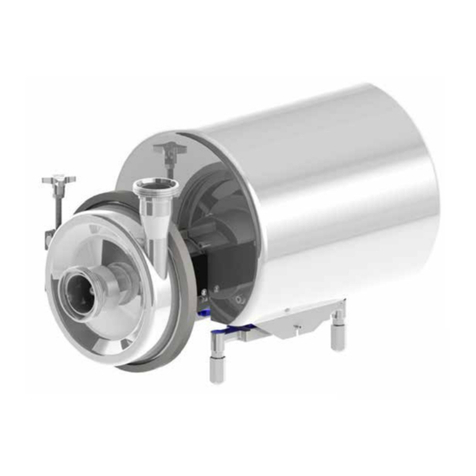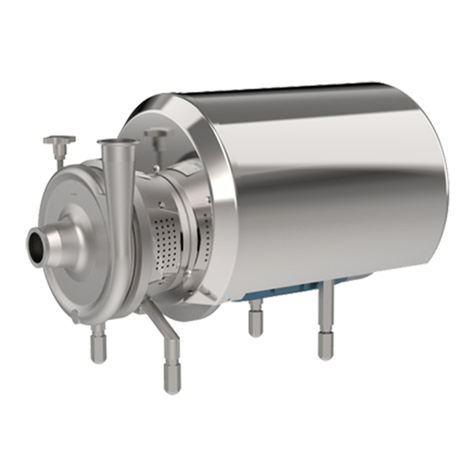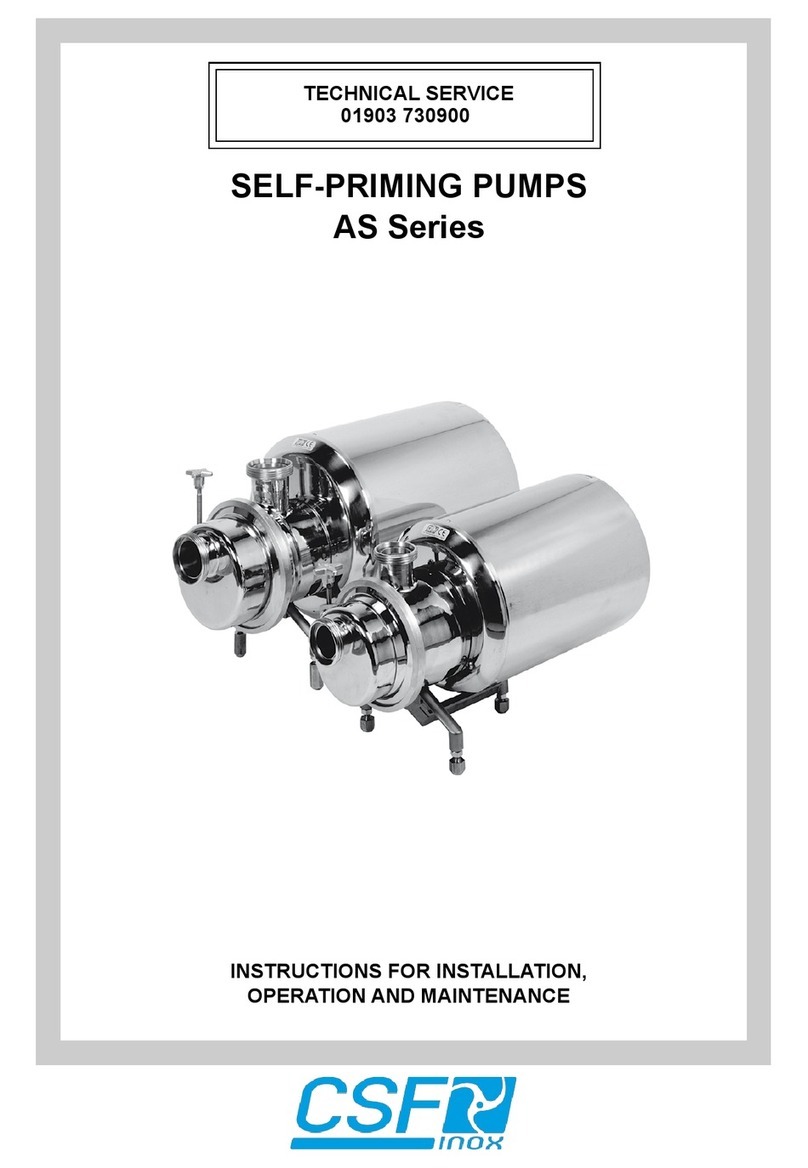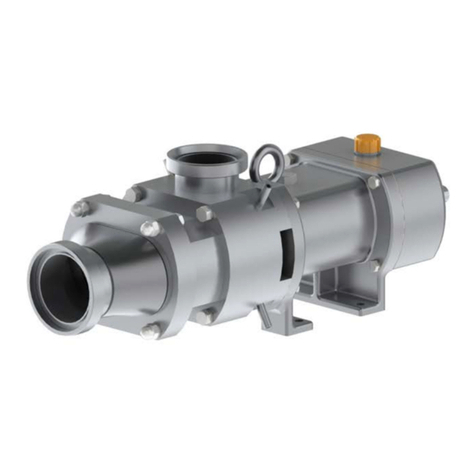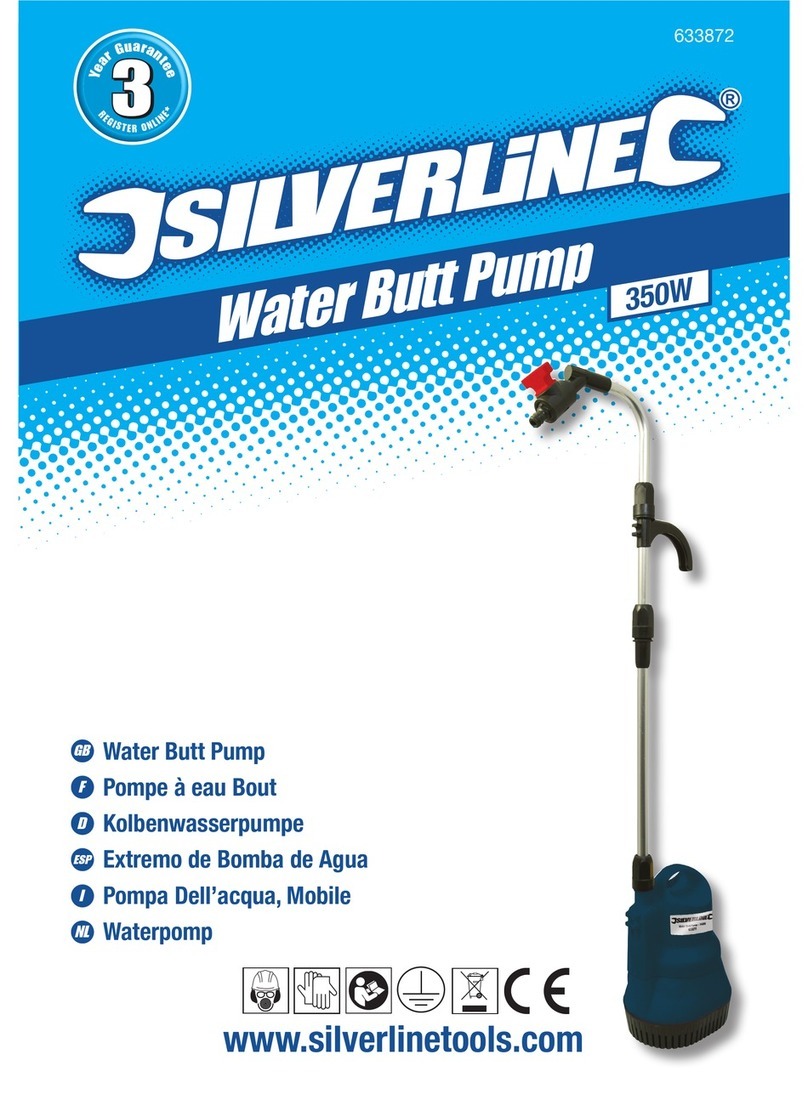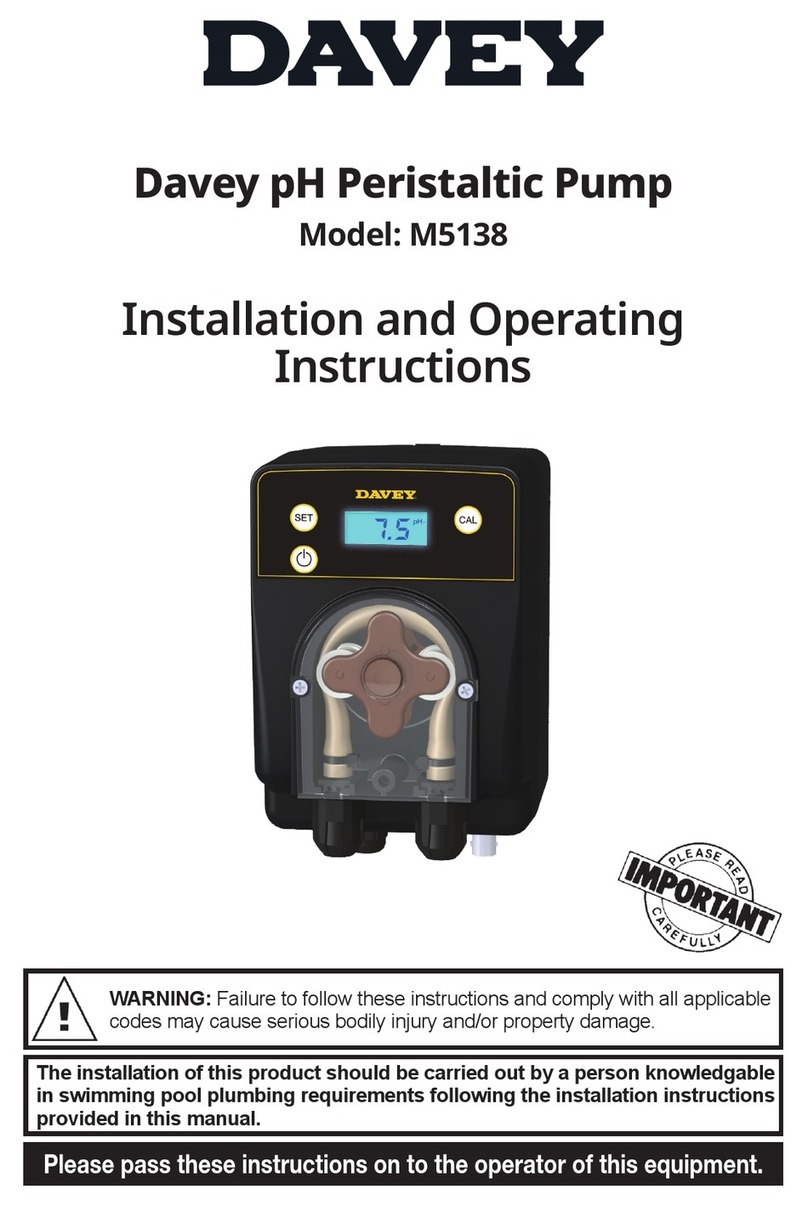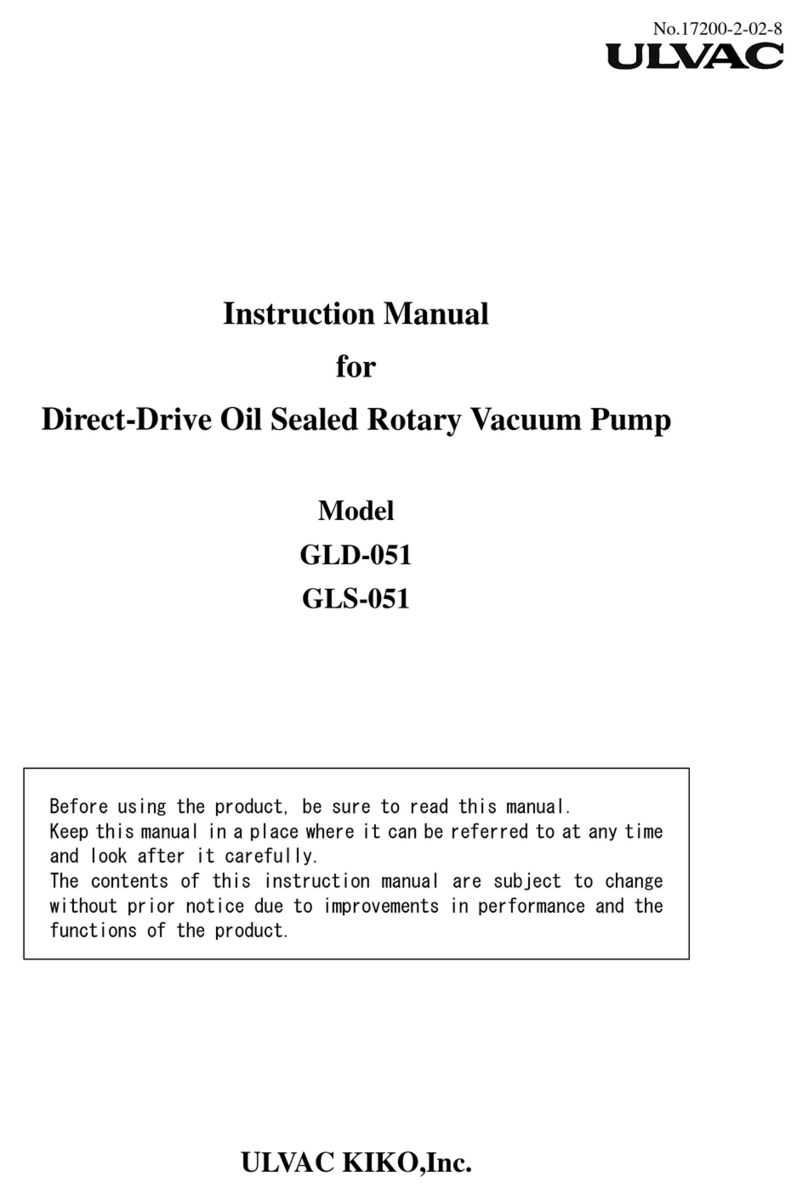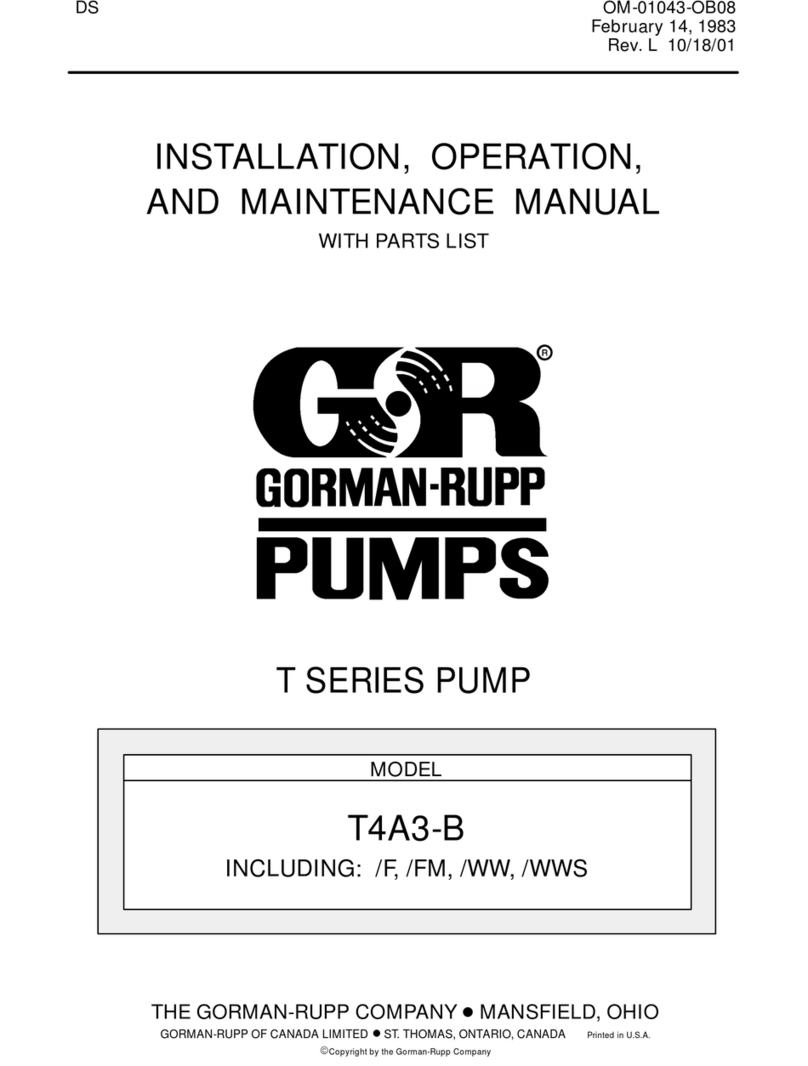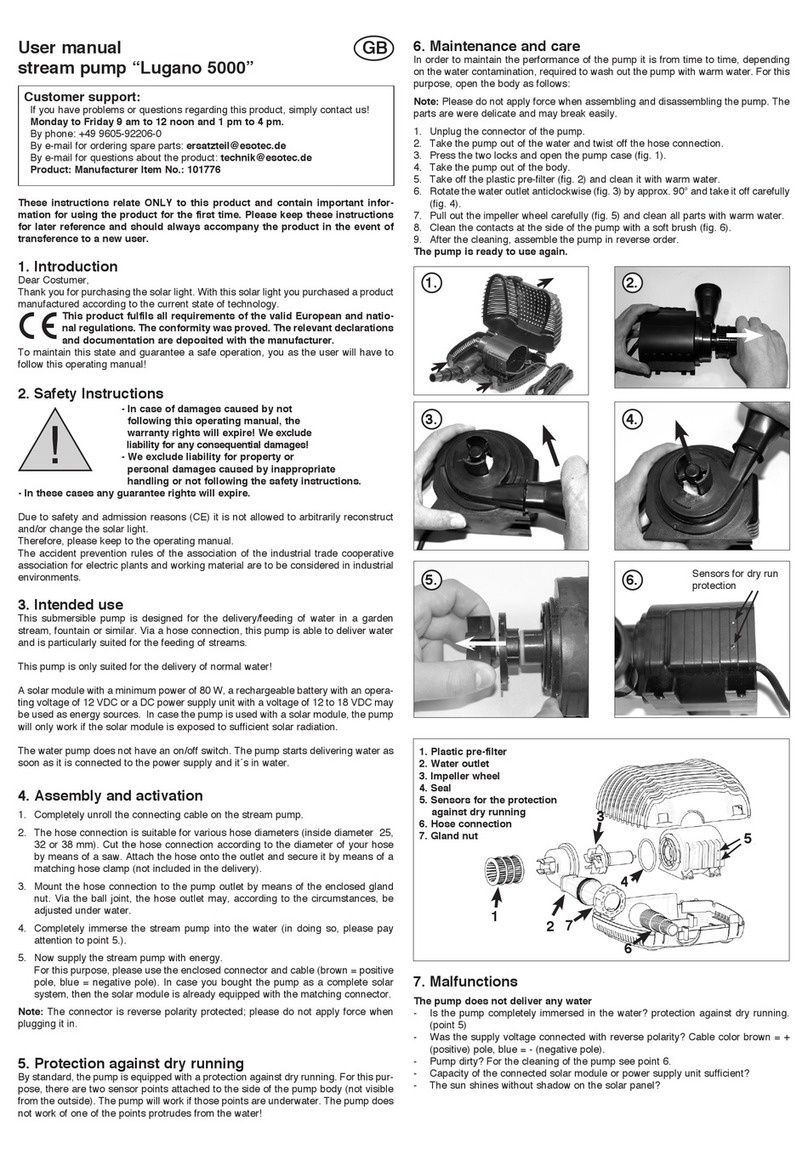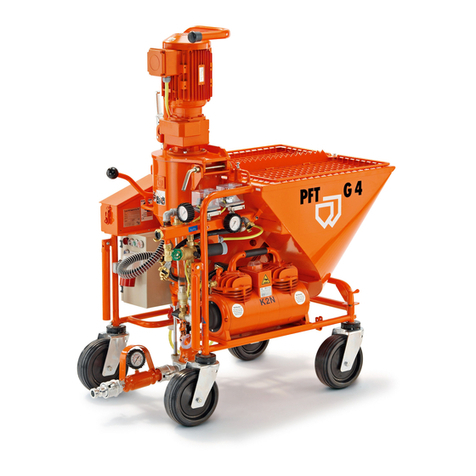CSF Inox CS Series Programming manual

INSTRUCTIONS FOR INSTALLATION,
OPERATION AND MAINTENANCE
CENTRIFUGAL PUMPS
CS Series


3
C.S.F. Inox S.p.A. reserves all rights concerning this manual and the object
presented herein.
The receiving party shall recognize these rights and undertakes, in the absence
of our explicit written authorization, not to use this manual for any purpose other
than that for which it was created.
Any violations will be dealt with in accordance with the law.
All rights reserved.
© Copyright by
C.S.F. Inox S.p.A.
Strada per Bibbiano, 7
42027 Montecchio E. (RE) - ITALY EU
www.csf.it
Self-printed
Version: 01 Date: 04/08/2020

4
Translation of the original instructions
INDEX
FOREWORD ........................................................................................................................................................... 6
1.0 - SYMBOLS .........................................................................................................................................................6
2.0 - SAFETY WARNINGS......................................................................................................................................6
3.0 - GUARANTEE .................................................................................................................................................. 7
4.0 - GOODS TRANSPORTATION, RECEIVING AND TRANSFERRING ..........................................................7
4.1 - TRANSPORT .............................................................................................................................................7
4.2 - RECEIPT ....................................................................................................................................................7
4.3 - INSTALLATION SITE PREPARATION.....................................................................................................7
4.4 - HANDLING.................................................................................................................................................8
5.0 - RETURN .......................................................................................................................................................... 8
6.0 - DESCRIPTION .................................................................................................................................................8
6.1 - TECHNICAL DATA.....................................................................................................................................8
6.2 - SOUND PRESSURE LEVEL ....................................................................................................................9
6.3 - WEIGHTS.................................................................................................................................................. 9
7.0 - NON-PERMITTED USES.................................................................................................................................9
8.0 - SET-UPS ........................................................................................................................................................ 13
9.0 - CSK SERIES INSTALLATION .......................................................................................................................14
9.1 - INSTALLATION ON FOUNDATION PLINTH.........................................................................................14
9.2 - INSTRUCTIONS ON ASSEMBLING CSK COUPLINGS......................................................................14
TYPE "A" ELASTIC COUPLINGS ............................................................................................................14
COUPLINGS WITH SPACER TYPE A..-SP.............................................................................................16
10.0 - INSTALLATION.............................................................................................................................................17
10.1 - SUCTION AND INFLOW CONDITIONS ..............................................................................................17
10.2 - PIPING................................................................................................................................................... 17
10.3 - ELECTRICAL CONNECTION...............................................................................................................18
11.0 - OPERATION..................................................................................................................................................19
11.1 - PRELIMINARY OPERATIONS AND START-UP..................................................................................19
11.2 - PROLONGED STOP..............................................................................................................................20
11.3 - CLEANING THE PUMP.........................................................................................................................20
12.0 - SPARE PARTS..............................................................................................................................................21
12.1 - REFERENCE TABLE OF MAIN PARTS SUBJECT TO REPLACEMENT.........................................21
12.2 - RECOMMENDED SUPPLY ..................................................................................................................21
13.0 - WORKING IRREGULARITIES ...................................................................................................................22
14.0 - SEALS ...........................................................................................................................................................25
14.1 - SINGLE MECHANICAL SEALS ...........................................................................................................25
14.2 - DOUBLE MECHANICAL SEALS - CS / CSX.......................................................................................26
14.3 - DOUBLE MECHANICAL SEALS - CSK ...............................................................................................27
15.0 - PUMP DISASSEMBLY .................................................................................................................................29
15.1 - DISASSEMBLY OF PUMP "T/W" EXEC...............................................................................................29
15.2 - DISASSEMBLY OF PUMP "Q" EXEC. ...............................................................................................32
15.3 - DISASSEMBLY OF PUMP "V" EXEC...................................................................................................32

5
16.0 - PUMP ASSEMBLY........................................................................................................................................34
16.1 - ASSEMBLY OF PUMP "T/W" EXEC.....................................................................................................34
16.2 - ASSEMBLY OF PUMP "Q" EXEC. ......................................................................................................34
16.3 - REFERENCE TABLE FOR IMPELLER NUT DIMENSIONS .............................................................34
16.4 - REFERENCE TABLE FOR CLAMP TIGHTENING TORQUES .........................................................34
16.5 - REFERENCE TABLE FOR IMPELLER - COVER ASSEMBLY ALLOWANCE..................................35
17.0 - BEARINGS MAINTENANCE .......................................................................................................................35
17.1 - SERIES CS BEARINGS MAINTENANCE ...........................................................................................35
17.2 - SERIES CS - CSX BEARINGS MAINTENANCE WITH HOUSING SIZE 160÷200 .........................35
17.3 - SERIES CSK BEARINGS MAINTENANCE.........................................................................................37
17.4 - CSK PUMP DISASSEMBLY..................................................................................................................38
17.5 - PUMP CSK ASSEMBLY ........................................................................................................................39
18.0 - SPECIAL EXECUTIONS..............................................................................................................................40
18.1 - EXECUTION WITH INDUCER (CS - CSK - CSX)...............................................................................40
18.2 - EXECUTION WITH HEATED CASING AND COVER (CS - CSK - CSX) ..........................................41
18.3 - CSD SERIES - ASEPTIC SANITARY CENTRIFUGAL PUMP ...........................................................42
19.0 - CLEANING PROCEDURE ..........................................................................................................................45
19.1 - EXTERNAL CLEANING .......................................................................................................................45
19.2 - CLEANING OF INTERNAL PARTS......................................................................................................45
19.3 - CLEANING OF FOOD-CONTACT PUMPS .........................................................................................45
19.4 - CIP WASHING PROCEDURE ..............................................................................................................46
DECLARATION OF DECONTAMINATION .............................................................................................47
20.0 - WASTE DISPOSAL AND DECOMMISSIONING .......................................................................................48
20.1 - PACKAGING MATERIAL...................................................................................................................... 48
20.2 - WASTES RESULTING FROM MAINTENANCE OPERATIONS....................................................... 48
20.3 - DISPOSAL OF THE PUMP ..................................................................................................................48

6
(1)
(2)
(8)(7)(6)
(5)(4)(3)
FOREWORD
Read the instructions carefully and keep them for future consultation.
C.S.F. Inox S.p.A. reserves the right to make any changes to the documentation it deems necessary
without being obliged to update publications that have already been issued.
When requesting information, spare parts or assistance, always specify the pump type (2) and serial
number (3) in order to ensure fast and ecient service: the complete code is given on the plate and
in the purchase documents.
CSF Plate example
1. System itam provided by the client
2. Manufacturing series, size and execution
3. Serial number
4. Year of construction
5. Pump rotation speed
6. Installed power in kW
7. Motor voltage
8. Motor frequency
1.0 - SYMBOLS
Pay great attention to the text parts indicated
by this symbol. Compulsory foot and hand protection PPE:
gloves and safety shoes
Danger: the non-observance of instructions
can cause serious damages to persons and/
or objects. Compulsory respiratory tract PPE: mask
Danger: only skilled personnel is allowed to
carry out operations concerning the electric
parts. Danger: hot surfaces
2.0 - SAFETY WARNINGS
When the pump is working the following occurs:
-Mechanical parts are moving
-Pump casing, pipelines and articulations are under internal pressure. Therefore do not
remove any safeguard or locking, do not loosen screws or clamps, as this can cause
serious damage to persons or objects.
-Electric parts are in tension
- Non-observance of inspection and maintenance operations can cause damages to persons
and objects, especially when dangerous or toxic liquids are pumped.
-When pumping liquids at a temperature over 60°C, adequate protection and warning
signals are required.
-Operations on the electric parts have to be carried out by skilled personnel, according to
technical directions and law, on authorization of the responsible installer.
-Installation must ensure an adequate ventilation, in order to cool the engine, as well as
enough space for maintenance operations.
-Before carrying out any operations involving disassembly of the pump (inspection, cleaning,
seal replacement, etc.), the following preliminary operations must be carried out:
▪ switch o engine tension and disinsert electric connection
▪ Close the valves on the suction and outlet pipelines, in order to avoid the risk of
ooding;
▪ Use adequate protections for hands and face, if the pump contains liquids which are
injurious to health (for example acids, solvents, etc.)
▪ Consider if the liquid which ows out of the pump when disassembling is dangerous
and arrange for adequate safety measures.

7
3.0 - GUARANTEE
All products manufactured by C.S.F. Inox S.p.A. are guaranteed to the purchaser, for one year from
the date of purchase, against hidden defects in materials or manufacture, providing that they are
installed and used according to instructions and recommendations of the manufacturer.
The guarantee does not cover wear parts or repairs for damage caused by improper use, abrasion,
corrosion, negligence, defective installation, non-observance of inspection and maintenance
operations, use of non-genuine spare parts, accidents or any work carried out by the purchaser
designed to alter the machine's performance as indicated by the manufacturer.
Before returning to C.S.F. Inox S.p.A. any item to be substituted or repaired under guarantee,
inform about the problem the Customer Assistance Oce and follow instructions of the
manufacturer. Returned items must be properly packed in order to avoid damages during
transport and a technical report describing the defect and how it manifested itself must
accompany the returned item/s.
Any item with a presumed fault should be returned to C.S.F. Inox S.p.A. at the customer's expense,
accompanied by a Declaration of Decontamination (attached to page 46), unless otherwise agreed.
C.S.F. Inox S.p.A. will examine, repair and/or replace the returned piece and then send it back to the
purchaser on ex-works basis.
Should the piece be found under warranty, no further costs will be owed by the purchaser. If, on the
contrary, the fault is not found under warranty, all necessary reparations and replacements will be
charged at normal cost to the purchaser.
C.S.F. Commercial parts incorporated in C.S.F. Inox products are guaranteed by their corresponding
manufacturers.
4.0 - GOODS TRANSPORTATION, RECEIVING AND TRANSFERRING
4.1 - TRANSPORT
The packings of all pumps manufactured by C.S.F. Inox S.p.A. are dened when placing the
order. Unless prior arrangements are made, goods will be packed only for transit conditions and
not for long-term storage; in case it should be necessary to store the pumps outside, you are
requested to cover the pumps appropriately in order to protect the electrical parts (motor) from
rain, dust, humidity etc.
4.2 - DELIVERY
On delivery of the supply it is essential to make sure that the packaging has not been
damaged during transport so that any claims can be made immediately to the carrier.
Should any damage be ascertained, the following procedure must be observed:
Accept the goods with reserve
Take photographic evidence of the damage
Notify the carrier of the damage sustained via registered mail with the photographic evidence
attached.
4.3 - SITE PREPARATION
It is the user's responsibility to:
- Prepare the installation sites as prescribed by local legislation governing health and safety in the
workplace
- Make sure the electrical power supply is compliant with the legislation in force and
possesses an ecient earthing system.
LIGHTING
The machine installation site must have adequate natural and/or articial lighting in compliance
with the legislation in force in the country of installation.

8
Lighting must be uniform, guarantee good visibility in every part of the machine and must not
create hazardous reections. It must also be such that commands on the control panels and
emergency stop buttons can be clearly seen.
4.4 - TRANSFERRING
Carry the packed pumps as close as possible to the place of installation by means of
appropriate lifting devices and unpack them. During this operation take care, as unsteady
parts could fall down.
The material used for packing should be properly disposed of, according to the
corresponding rules in force in receiver’s country.
After unpacking the pump, use special lifting belts and move the pump-motor-set to
the place of installation; never use the eyebolts on the motor to move the pump, as the
eyebolts are for moving the motor only.
In versions complete with shroud, take the shroud o before moving the pump-motor-set, in
order to avoid damages.
Observe the health & safty regulations in force locally.
Fig. 1
5.0 - RETURNS
▪ Empty the pump correctly
▪ Wash and thoroughly clean the pump, especially in the case of harmful or explosive liquids
▪ Thoroughly dry the pump
▪ A duly compiled Declaration of Decontamination must accompany the pump (see page 47).
6.0 - DESCRIPTION
The CS series comprises single-stage centrifugal pumps with axial suction port, open centrifugal
impeller and trapezoidal volute casing. All models have threaded connections for ttings to DIN
11851 standards (unless otherwise requested) and all models are tted with mechanical seals. The
materials used for the components and the mechanical seal are chosen according to the liquid to be
pumped.
They are tted with three-phase electric motors compliant with the legislation in force and IP 55
protection rating, unless otherwise specied.
They are designed exclusively for professional use.
6.1 - TECHNICAL DATA
- Maximum operating pressure: 10 bar up to 100°C
- Temperature range: -20°C to 100°C (on request, up to 140°C for water and up to 190°C for edible oil).
The operating temperature range is determined by the type of mechanical seal and the material
of the elastomers used.
If there is any need to use the pump with dierent performance data and product characteristics
to those indicated at the time of ordering, contact C.S.F. Inox S.p.A. to make sure the pump is
suitable for your requirements.
Fig. 2

9
6.2 - SOUND PRESSURE LEVEL
The sound pressure level of centrifugal pumps is the following (see table):
The measurement has been made by means of a phon-meter placed at 1 m distance from the
pump and at a height of 1.6 m from the ground.
Preliminary condition is that the pump is xed correctly; the above mentioned values do not take
into account external noise sources (e.g. valves, abrupt hydraulic deections).
6.3 - WEIGHTS
The weight may vary depending on the execution (see types on page 13), the make and/or model
of the motor installed.
For the weight of the pump, please refer to the data sheet accompanying the instructions.
7.0 - NON-PERMITTED USES
Do NOT use the pump in the following cases:
- With a suction pressure greater than the specied value (0.5 times the discharge head generated
by the pump).
- Without guards and/or with disabled, faulty or missing safety devices.
- If it has not been installed correctly.
- If there are power supply faults.
- In the event of serious maintenance shortcomings.
- Following unauthorized modications.
- For improper use of the machine.
- Without following the instructions provided.
The pump must always be used in an environment appropriate to the level of protection of the motor.
Always check this on the motor plate before installation.
THE PUMP MAY NOT BE USED IN ENVIRONMENTS WHICH REQUIRE A HIGHER LEVEL
OF PROTECTION OR A HIGHER SPECIFICATION MOTOR OR ELECTRICAL PARTS.
Components complying with the safety standards for the environment in question must be used.
PUMP TYPE
Noise index dB(A)
< 70
CS 25-145 4-pole CS 25-175 4-pole CS 32-110 4-pole
CS 32-145 4-pole CS 32-175 4-pole CS 32-210 4-pole
CS 32-260 4-pole CS 40-145 4-pole CS 40-175 4-pole
CS 40-210 4-pole CS 40-260 4-pole CS 50-145 4-pole
CS 50-175 4-pole CS 50-210 4-pole CS 50-260 4-pole
CS 65-145 4-pole CS 65-175 4-pole CS 65-210 4-pole
71 ÷ 75
CS 25-145 2-pole CS 25-175 2-pole CS 32-110 2-pole
CS 32-145 2-pole CS 32-175 2-pole CS 65-260 4-pole
CS 80-175 4-pole CS 80-210 4-pole CS 80-260 4-pole
76 ÷ 80
CS 32-210 2-pole CS 40-145 2-pole CS 40-175 2-pole
CS 40-210 2-pole CS 50-145 2-pole CS 50-175 2-pole
CS 50-210 2-pole
81 ÷ 85
CS 32-260 2-pole CS 65-145 2-pole CS 100-260 4-pole
CS 40-260 2-pole CS 65-175 2-pole CS 125-260 4-pole
CS 50-260 2-pole CS 80-310 4-pole CS 100-310 4-pole
CS 80-175 2-pole
86 ÷ 90 CS 65-210 2-pole CS 65-260 2-pole CS 80-210 2-pole
CS 80-260 2-pole CS 100-210 2-pole CS 100-260 2-pole

10
TABLE OF WEIGHTS FOR CS PUMPS - MOTORS FROM 0.37 KW TO 4 KW (IEC 71-112 FRAME SIZE)
Pump type
1450 revs/min
kW
Weight
kg Pump type
1450 revs/min
kW Weight
kg Pump type
2900 revs/min
kW Weight
kg
CS 25-145
0.37
27
CS 50-175
0.55 42
CS 25-145
0.55 26
0.55
32 0.75 44 0.75 32
0.75
37 1.1 46 1.1 34
CS 25-175
0.37
30 1.5 50 1.5 40
0.55
34 2.2 73 2.2 43
0.75
42 3 69
CS 25-175
0.75 35
CS 32-110
0.37
24 4 72 1.1 37
0.55
28
CS 50-210
1.1 49 1.5 42
0.75
33 1.5 52 2.2 45
CS 32-145 0.55
35 2.2 77 3 60
0.75
40 3 73 4 69
CS 32-175
0.55
37 4 76
CS 32-110
0.55 23
0.75
42
CS 50-260
2.2 86 0.75 29
1.1
46 3 82 1.1 31
CS 32-210
0.75
44 4 86 1.5 36
1.1
50 CS 65-145 1.1 48
CS 32-145
0.75 36
1.5
50 1.5 51 1.1 37
2.2
74
CS 65-175
1.1 50 1.5 43
3
70 1.5 53 2.2 46
CS 32-260
1.1
58 2.2 76 3 56
1.5
61 3 72 4 65
2.2
84 4 76
CS 32-175
1.5 45
3
80
CS 65-210
1.5 60 2.2 48
4
84 2.2 81 3 56
CS 40-145 0.55
36 3 77 4 67
0.75
41 4 81 CS 32-210 3 62
CS 40-175
0.75
43 CS 65-260 3 86 4 69
1.1
46 4 90
CS 40-145
1.5 42
1.5
49
CS 80-175
2.2 82 2.2 45
CS 40-210
0.75
47 3 78 3 57
1.1
51 4 82 4 66
1.5
54
CS 80-210
2.2 85
CS 40-175
2.2 49
2.2
76 3 81 3 60
CS 40-260
1.5
62 4 85 4 66
2.2
84 CS 80-260 4 93 CS 40-210 3 61
3
80 4 73
4
84
CS 50-145
1.5 45
CS 50-145
0.75
43 2.2 48
1.1
45 3 59
1.5
48 4 68
CS 50-175 3 61
4 70
CS 65-145 3 61
4 70

11
TABLE OF WEIGHTS FOR CS PUMPS - MOTORS FROM 5.5 KW TO 22 KW (IEC 132-180 FRAME SIZE)
Pump type
1450 revs/min
kW
Weight
kg Pump type
1450 revs/min
kW Weight
kg Pump type
2900 revs/min
kW Weight
kg
CS 65-260
5.5
117
CS 32-210
5.5 98
CS 50-210
5.5 107
7.5
126 7.5 104 7.5 113
9.2
135 9.2 110 9.2 120
11
195 11 157 11 163
CS 80-175 5.5
110
CS 32-260
5.5 107 15 170
7.5
118 7.5 113 18.5 179
CS 80-210 5.5
113 9.2 120 22 221
7.5
122 11 176
CS 50-260
15 188
CS 80-260
5.5
119 15 184 18.5 196
7.5
128
CS 40-175
5.5 96 22 233
9.2
137 7.5 102
CS 65-145
5.5 98
11
195 9.2 110 7.5 104
15
202 11 153 9.2 111
CS 80-310
11
205
CS 40-210
5.5 100 11 157
15
212 7.5 107
CS 65-175
5.5 100
18.5
255 9.2 114 7.5 106
22
266 11 160 9.2 113
CS 100-210 5.5
116 15 165 11 160
7.5
125
CS 40-260
7.5 114 15 167
CS 100-260
9.2
148 9.2 121 18.5 176
11
204 11 176 22 218
15
211 15 185
CS 65-210
11 173
18.5
252 18.5 194 15 181
CS 100-310
11
209 22 237 18.5 191
15
216 CS 50-145 5.5 95 22 229
18.5
258 7.5 101
CS 65-260
15 190
22
270
CS 50-175
5.5 97 18.5 200
CS 125-260
9.2
160 7.5 103 22 237
11
215 9.2 110
CS 80-175
11 173
15
222 11 157 15 180
18.5
264 15 164 18.5 190
22 227
CS 80-210
15 186
18.5 195
22 232
CS 100-210 22 238

12
TABLE OF WEIGHTS FOR CSK EXECUTION PUMP (2ND-3RD GROUP)
Pump type
2nd Group
Weight
kg Pump type
3rd Group
Weight
kg
CSK 32-145 21 CSK 65-210 52
CSK 32-175 23 CSK 65-260 62
CSK 32-210 25 CSK 80-175 46
CSK 40-145 22 CSK 80-210 54
CSK 40-175 24 CSK 80-260 64
CSK 40-210 26 CSK 100-210 57
CSK 50-145 27 CSK 100-260 72
CSK 50-175 23 CSK 100-310 80
CSK 50-210 27 CSK 125-260 86
CSK 65-175 29
Pump type
4° Gr.
Weight
kg
CSK 125-350 157
CSK 150-350 194
TABLE OF WEIGHTS FOR CSK EXECUTION PUMP (4TH GROUP)
TABLE OF WEIGHTS FOR CSK EXECUTION PUMP - MOTORS FROM 30 - 37KW (IEC200 FRAME SIZE)
Pump type rpm kW Weight
kg
CSX 50-260
2-pole
30-37 322
CSX 65-260 30-37 326
CSX 80-175 30-37 323
CSX 80-210 30-37 328
CSX 80-260 30-37 336
CSX 80-310 30-37 386
CSX 100-210 30-37 331
CSX 100-260 30-37 341
CSX 100-310 30-37 392
CSX 125-260 30-37 404

13
8.0 - EXECUTIONS
CS - shroudless execution with adjustable support
feet from 0.37kW to 4 kW
CS - shrouded execution with
adjustable support feet from 0.37 kW to 4 kW
CS - shroudless execution with xed
support feet from 0.37 kW to 22 kW
CS - shrouded execution with
xed support feet from 5.5 kW to 22 kW
CS - shroudless execution with adjustable
support feet from 5.5 kW to 22 kW
CS - shrouded execution with adjustable
support feet from 5.5 kW to 22 kW
CSX - shroudless execution 30 kW CSX - shrouded execution 30 kW
CSK - bare shaft execution CSK - execution with joint and base

14
9.0 - CSK SERIES INSTALLATION
9.1 - INSTALLATION ON FOUNDATION PLINTH
The foundation plinth must be of the required structure and solidity. It must be prepared based on
the dimensions provided in the dimensions sheet/installation diagram.
Proceed as follows:
1 Thickness
2 Thickness with (L) > 800 mm
3 Foundation bolt
LDistance between foundation
bolts
1. The pump unit must be positioned on the foundation plinth and aligned with the help of a spirit
level positioned on the shaft and discharge port. Maximum permitted tolerance: 0.2 mm/m.
2. If necessary insert levelling shims (1) always on both the left and right near the foundation bolts
(3) between the base plate/frame.
If the distance of the foundation bolts is (L) >800 mm, insert further shims (2) at the centre of
the base plate. All shims must be perfectly at.
3. Insert the foundation bolts (3) in the relative holes.
4. The foundation bolts (3) must be then grouted into the foundation plinth.
5. After the grouting has set, align the base plate.
6. Uniformly tighten the foundation bolts (3) all the way home.
7. Grout in the base using controlled shrinkage cement with a water/cement ratio of ≤ 0.5.
Perform post-treatment of the concrete in compliance with standard EN 206.
8. The pump-motor set is aligned on the base at the C.S.F. plant before it is shipped. After
performing installation, securing the unit to the foundation and connecting the suction
and delivery piping, recheck alignment.
9. Before starting the unit the joint guard must be installed, after which this can only be
removed by qualied personnel for the purpose of carrying out inspections and/or
maintenance work and only after the unit has been stopped and disconnected from the
electrical power supply.
Misalignments cause strain and vibrations on the drive which in turn will lead to
untimely wear and breakage of the joint and bearings.
9.2 - INSTRUCTIONS ON ASSEMBLING CSK COUPLINGS
TYPE "A" ELASTIC COUPLINGS
1. Assembling the hubs
When installing the hubs on the shafts, do not forget the sealing ring installed on the two hubs.
Check the grub screws on the hubs are fastened and tightened correctly. If the coupling is used
in an ATEX area, secure the grub screw between hub and shaft further, for example using Loctite
(medium strength) or similar.
2. Radial alignment
The radial alignment is controlled with a rule or a dial indicator or laser. By resting the rule on the
periphery of the hubs and matching up two opposite teeth, you will have a suciently broad line
of contact to check they match up throughout their surface area. Better alignment precision is
obtained with the help of a dial indicator or laser (keep to radial tolerance Y).

15
1 2 3
4 4
5 5
3. Axial and angular alignment
Position the hubs at distance E, as for Table 1. Using the thickness feelers, you can control the
gap between hubs, measurement E (keep to axial tolerance X). It is advisable to check the values
of measurement E in three positions (O-90-180 degrees), as this will ensure more precise angular
alignment (keep to angular alignment Z).
4. Assembling the elastic insert
Once the two hubs have been aligned, proceed to assemble the elastic insert in the slots formed
by the parallel teeth. If the radial and angular alignment is correct, the ends of the elastic insert,
once closed, should match up in their development and width. The elastic insert has two types
of housing: a through housing, with dual inlets, for horizontal work, and a single-inlet housing for
vertical work.
5. Assembling the ring
Once the elastic insert has been tted, the retention ring can be inserted manually, by matching
up one of the two reference Iines on the outside of the ring with the insertion grooves on the
elastic insert. Using a nylon mallet, install the retention ring, tapping delicately and alternately on
each side of the two areas corresponding to the reference marks on the ring.
6. Securing the ring
Once the ring has been installed on the elastic insert, it needs to be fastened by inserting the two
set screws (Tab. 2) into the threaded housings, which match up with those for the elastic insert.
We recommend securing the tightness of the set screws by applying Loctite (medium strength)
to the screw-threading. Any potential axial displacement of the ring, due to misalignment of the
equipment, is thereby secured.

16
DIN 913
6 7
2
1
7. Disassembly
Remove the two set screws from the ring. Shift the ring by tapping it on the side with a nylon
hammer in the areas the pins (reference lines) are housed.
PERMITTED SALIGNMENT TOLERANCES
COUPLINGS WITH SPACER TYPE A..-SP
1. Assembling the hubs
Once the hubs have been tted and secured with the setscrews, proceed to line them up, leaving
gap DBSE (140 mm) to insert the spacer body. Do not gorget to t the attachment ring rst.
2. Alignment and assembly
Once the spacer body has been attached to the ange hub, and the screws secured with their
tightening torque (table 4), position the hub and the spacer body at distance E, as for table 3
(keeping to axial tolerance X).
Tab. 1
Type A00 A0 A1 A2 A3 A4 A45 A5 A55 A6 A7 A8 A9 A10 A11
E1.5 1.5 1.5 2.5 2.5 3.5 3.5 3.5 3.5 3.5 4 5 5 6 6
Axial X +0.3 +0.3 +0.5 +0.5 +0.7 +0.8 +1.0 +1.0 +1.0 +1.0 +1.0 +1.5 +1.5 +1.5 +1.5
Radial Y 0.2 0.3 0.3 0.5 0.5 0.7 0.7 0.7 0.8 0.8 1.0 1.0 1.0 1.5 1.5
Angular Z 0.10 0.10 0.20 0.20 0.30 0.40 0.40 0.50 0.50 0.60 0.90 1.10 1.30 1.70 1.70
Tab. 2
Type A00 A0 A1 A2 A3 A4 A45 A5 A55 A6
DIN 913 - - M5 M6 M8 M8 M10 M10 M10 M10
L- - 8 12 12 14 14 14 14 14
3. Next, proceed in the same way as for assembly of coupling A.

17
PERMITTED SALIGNMENT TOLERANCES
10.0 - INSTALLATION
10.1 - SUCTION AND INFLOW CONDITIONS
(NPSH = Net Positive Suction Head)
NPSHa (NPSH available)
In order to ensure that pump operation is free from cavitation, it is essential to observe the maxi-
mum permitted suction lift ha geo max or the minimum allowable head hc geo min.
NPSH of system (available NPSH)
The centrifugal pumps can operate correctly only if vapour has not formed inside. For this reason
the static head at the reference point for the NPSH is the centre of the impeller, that is the point of
intersection of the pump shaft axis with the vertical plane that passes through the external points
of the blade inlet corners.
NPSHr (required NPSH) is the value required by the pump, expressed in metres, obtained from
the performance curve. In practice 0.5 m should be added to this value as a safety margin.
10.2 - PIPING
In order to prevent the creation of harmful stresses, the suction and discharge pipes must be
connected to the pump ports without the use of force. These pipes must also be supported
independently avoiding causing stresses on the pump. The internal diameter must be the same
size as the pump connections. It must in any case not be smaller to avoid head loss and/or poor
performances. Always use elbows with large radius. If the pipe diameter changes along the
line, use reduction cones, choosing the ones that are most suitable to avoid any formation of air
pockets (Pict.1).
Tab. 3
Dimension (E) and tolerance in mm.
Type A1C A2C A3C A4C A45C A5C A55C A6C A7C A8C
E3.0 3.0 3.5 3.5 3.5 3.5 4.0 4.0 4.0 4.0
Axial X +0.5 +0.5 +0.7 +0.8 +1.0 +1.0 +1.0 +1.0 +1.0 +1.5
Radial Y 0.1 0.1 0.15 0.20 0.20 0.20 0.20 0.20 0.30 0.30
Angular Z 0.20 0.20 0.30 0.40 0.40 0.50 0.50 0.60 0.90 1.1
Tab. 4
Grub screws-flange tightening torque
Type A1 A2 A3 A4 A45 A5 A55 A6 A7 A8
DIN 912 M6 M6 M8 M8 M10 M10 M10 M10 M12 M14
TQ (Nm.) 14 14 35 35 69 69 69 69 120 205
NO YES
Fig. 1

18
h min. = + 0,1
Va2
2g
hmin = m
V= m/s
360°
STD
The suction pipe must be as short as possible and rise as it moves towards the pump if it is
sucking from a tank (Pict.2). If on the other hand the pump is below the level of the liquid, the
pipe should descend slightly (Pict.3). If the pump is used for transporting hot liquids, t expansion
joints to compensate any expansion of the piping. The maximum velocity of the liquid in the
suction pipe must not be greater than 3 m/s. Velocities between 1 and 2 m/s are recommended.
Fig. 3
Fig. 2
The suction pipe must be designed in such a way as to prevent air from entering the pump.
For this reason, when sucking from a tank located at a lower level, the pipe must reach below the
free surface of the liquid. In order to prevent the formation of vortices and avoid the risk of sucking
in air, always keep a minimum head at the pipe inlet (h. min.) equal to at least the dynamic head
plus a safety margin of 0.1 m (Pict.2).
In order to prevent the formation of vortices when it is not possible to observe the values of
minimum available head, it is possible to t crosses in the piping. This system is suitable even for
tanks with a positive head.
Avoid creating obstacles which could increase suction losses disrupting smooth uid ow. Make
sure that there are no restrictions, sharp turns or tight elbows on the discharge line, since these
increase disturbance.
During electro-welding work never use the pump as an earthing point and make sure the current
does not ow through the bearings.
Before using the pump, make sure the tank and piping are clean and examine the inside of the
pump before connecting the piping.
It is possible to install the CS pump in a self-draining position by rotating the casing to the 360°
position, as shown in the gure. This conguration must be agreed upon with C.S.F. Inox S.p.A. at
the time of ordering.

19
10.3 - ELECTRICAL CONNECTION
Make the electrical connection only after the hydraulic connection has been completed;
set up the motor control system in conformity with the technical standards and regulations
in force (EN 60204-1): in particular a manual electric power switch must be installed with
adequate current switching capacity; devices for overcurrent and overload protection (e.g.
fuses, automatic switches, etc.) must also be tted, plus, if necessary, a device to prevent
accidental restarting.
Check that the main frequency and voltage and the available power are suitable for the
motor installed. All the material used for the electrical connection (cables, cable clamps,
switches and shielding) must have a suitable level of protection for the environment in
which it is installed.
Be sure to use cables of sucient cross-section for the current shown on the motor plate
so as to prevent them from overheating.
Before doing anything else, make the motor's earth connection, using the terminal on the
motor and a cable of sucient cross-section. The cables may be connected to the terminal
board using either a delta or star arrangement. Follow the data given on the motor plate
for the main voltage, as shown in the diagram in pict.4; when starting, the motor's current
absorption increases briey to 5-6 times the nominal value. If the mains supply is unable to
substain this increase in absorption, use a star-delta starter or other kind of device (e.g. an
autotransformer).
Pict.4
Lower
voltage
Lower
voltage
C.S.F. Inox S.p.A. will accept no responsibility for damage to property and/or injury to
persons caused by failure to comply with the technical standards and regulations in force.

20
Direction of motor
rotation
11.0 - OPERATION
11.1 - PRELIMINARY OPERATIONS BEFORE START-UP
- Check that the pump turns freely under hand pressure
- The clamp joining the pump casing and the lantern bracket must be well tightened and it should
not be easily unscrewed by hand.
The clamp must be tightened using a wrench and NOT simply by hand.
- Check the that the pump turns in the marked direction as described in the gure
(counterclockwise as seen from the pump side).
- The suction pipe and the pump must be lled with liquid. There are two possible cases:
a) When the pump is to operate with a negative suction head, it must be primed by introducing
liquid into the pump casing.
b) When the pump is to operate below the level of the suction liquid, i.e. with a positive head,
the suction and discharge gate valves must be opened until the pressure gauge on the pump
discharge shows a pressure corresponding to the positive suction head.
c) If the sealing chamber is to be cooled, open the cooling water supply and adjust the ow.
- After carrying out the preliminary operations, then close the discharge valve completely and
make sure that the suction valve is completely open.
- Start the pump and check once again that it rotates in the right direction.
OPERATING CHECKS
- If the pump does not generate the required discharge head rapidly, stop and repeat the priming
operations.
- If the delivery gate valve is opened more than necessary, i.e. further than the specied working
point, and the pump is operating with a lower discharge head than that required, there will be an
increase in delivered capacity and absorbed power. If this occurs, throttle the discharge until the
required head and capacity values are obtained.
- If the discharge head generated by the pump is greater than that required, the diameter of the
impeller can be reduced. If, on the other hand, the head is lower than required, with equal ow
rate, an impeller with a larger diameter can be installed (provided that the one installed isn't
already the largest) and probably a more powerful motor is needed.
This manual suits for next models
27
Table of contents
Other CSF Inox Water Pump manuals
Popular Water Pump manuals by other brands

GORMAN-RUPP PUMPS
GORMAN-RUPP PUMPS SF4D Installation, operation, and maintenance manual with parts list

Barnes
Barnes UT17 manual
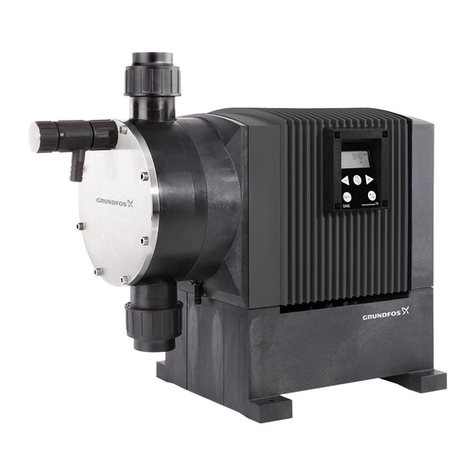
Grundfos
Grundfos DME 2 Product guide
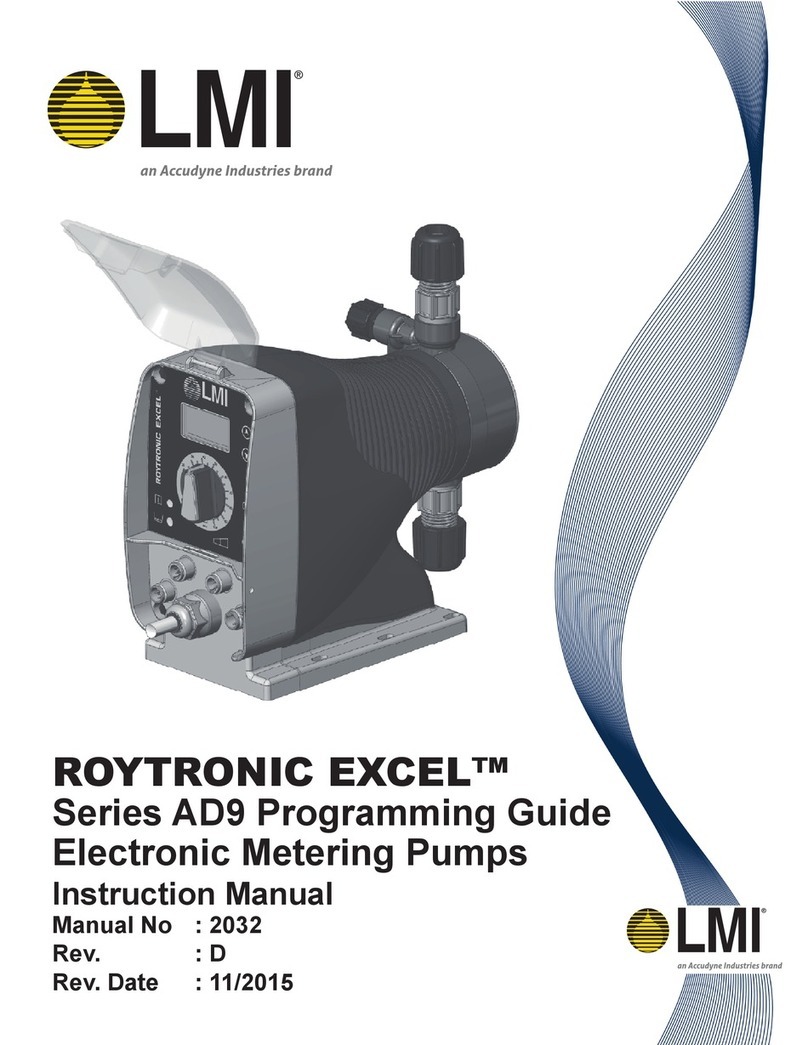
Accudyne Industries
Accudyne Industries LMI ROYTRONIC EXCEL AD9 Series instruction manual

GORMAN-RUPP PUMPS
GORMAN-RUPP PUMPS 80 Series Installation, operation, and maintenance manual with parts list

GORMAN-RUPP
GORMAN-RUPP PA6C60-4045T manual
